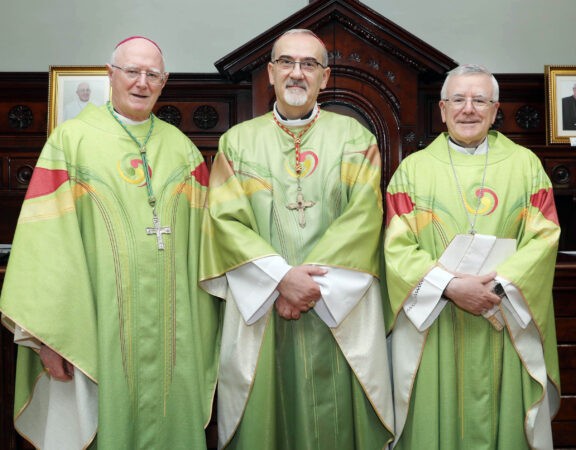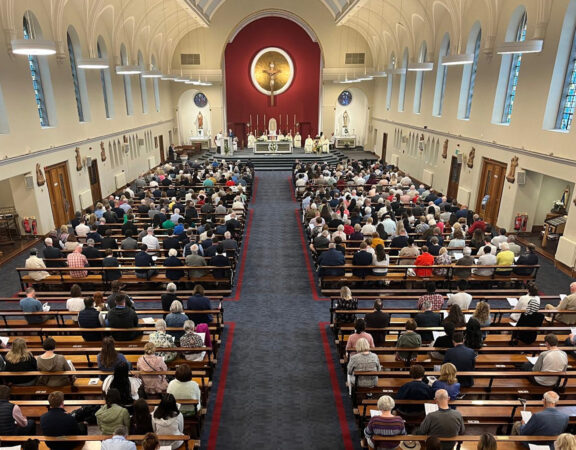Homily on Blessed Columba Marmion
in Holy Cross Church, Dundrum
by Dom Columba McCann – 30th September 2018
Your Grace, dear brothers and sisters. Everything I was hoping to say this evening about Blessed Columba Marmion, is already shown beautifully in the icon here.
If you look at the bottom of the picture you see words from Saint Paul: for me, to live is Christ. Blessed Columba would have found a similar message in the Rule of Saint Benedict which he lived as a monk: prefer nothing whatsoever to Christ. St Benedict wanted his monks to find Christ everywhere: in prayer, in celebrating the liturgy together, in the Abbot, in meditation on scripture, in the guests who come looking for a place to stay, and especially in those who are sick or poor. Putting Christ before all else.
You’ll see in the middle of the left hand side of the icon a picture of the Abbey of Maredsous, where Blessed Columba was abbot in first decades of the twentieth century. Talks he gave were put together into books by his listeners. The titles of these books tells you everything: Christ the Life of the Soul, Christ the Ideal of the Priest, Christ the Ideal of the Monk, Christ in His Mysteries. For me to live is Christ. Prefer nothing whatsoever to Christ.
You might be tempted to think that such a demanding idea as ‘prefer nothing whatsoever to Christ’ is fine for monks but not for everybody else. The problem is that St Benedict was quoting a bishop, who was speaking to everyone. St Cyprian, an early bishop of North Africa was the one who said we must prefer nothing whatsoever to Christ, and he also gave the reason why: because Christ has preferred nothing whatsoever to us. That’s where the church on the bottom right hand side of the icon comes in: Holy Cross, Dundrum. Christ gave everything for us on the cross, and asks that all of us, in every parish, prefer nothing to him.
I’m no expert in the world of business, but I can imagine that whenever a merger between two companies is being proposed, people have a long hard look at what they are taking on. If my truck rental company is going to merge with your van rental company then I will look very closely at what your company has to offer: what strengths, assets and opportunities will it bring, because they could be mine; also, what are it’s weaknesses, liabilities and risks because they will be mine too. If you look at the church further up on the right hand side, you will see a place where a kind of merger took place: St Paul’s Arran Quay, where Joseph Marmion was baptised. In your own mind you could add in a picture of the church where you were baptised.
In our baptism a merger took place between each of us and Jesus Christ. And we got a great bargain! All his assets are now ours: each of us is Son or Daughter of God in the same way that he is Son of God. That’s his gift to us. What about the weaknesses and liabilities? All our weaknesses, difficulties, failures and mistakes are his, and share in the redeeming power of his total weakness on the cross. We have merged with him. All that is his has become ours, and all that is ours has become his. This is the heart of the spiritual teaching of Blessed Columba, it comes straight from the Bible, and has a depth so great that it is hard to fathom. The magnificent baptismal font here in Holy Cross Church, Dundrum, speaks volumes about all of this. Every time you enter the church you can dip your hand back into the wonderful moment when you were made one with Christ.
Up on the top of the right-hand corner you see three angels, a traditional way to represent the Holy Trinity gathered, as it were, around a table. Because of the merger that has taken place, we have a place there, at the table of the Holy Trinity, so to speak. Archbishop Rowan Williams of Canterbury once said that when we pray we take the place of Christ. We stand in his shoes. Our life is through him, with him, in him. All that is his is ours, and all that is ours is his.
There may be times when our own lives seem on the verge of collapse, or we may be fooled into thinking our Church is about to collapse. That’s when Blessed Columba would have us look at the bigger picture: we have merged with Christ, with his death and resurrection. We are given his strength and he carries our weaknesses.
Blessed Columba used to receive dozens of letters asking for spiritual advice. Again and again he used to tell people to lean on Christ. He was very fond of those words of Jesus, ‘I am the vine and you are the branches… apart from me you can do nothing.’ He used to stress those words, pointing out that Jesus didn’t say, ‘apart from me you won’t achieve much’. He said, ‘apart from me you can do nothing’. So Blessed Columba would have us lean on Christ.
How did Blessed Columba lean on Christ? It is clear from his writings and from his diaries, that much of his personal inspiration came from daily meditation on the readings and prayers of the liturgy. There he found a deep and refreshing source of encouragement and life that he passed on to others. He knew the letters of St Paul off by heart!
He prayed the rosary daily. He said that if we really want to be formed in the identity of Christ then we must live in the same way: with God as our Father and Mary as our Mother. He also did the stations of the Cross every day. He found that meditating on the sufferings of Jesus gave him great inner strength in his own difficulties.
But he never imposed strict formulas or rules as to how each person was to arrange their spiritual practices from day to day. He wanted people to see the big picture: we have been grafted into Christ, we are part of him, we are merged with him, we are in the life of the Trinity in the same way that a child is adopted into a family.
For me to live is Christ. Prefer nothing whatsoever to him. Lean on him. Turn to God as your Father and to Mary as your Mother. Nourish your mind, heart and spirit on the scriptures and discover there and in the prayers of the liturgy a source of life and strength that goes far beyond the ups and downs of our daily struggle. Keep your eye on the big picture, and you yourself will become an icon of Christ. Ends







